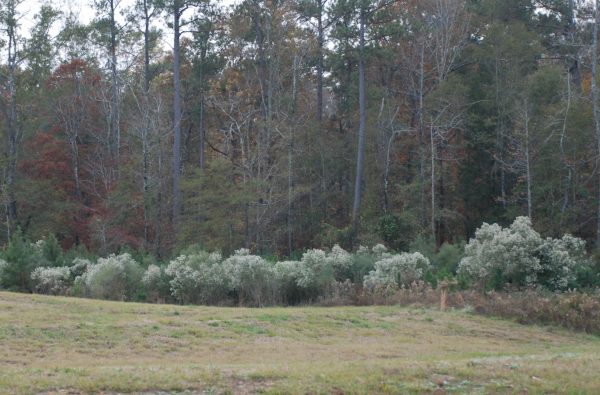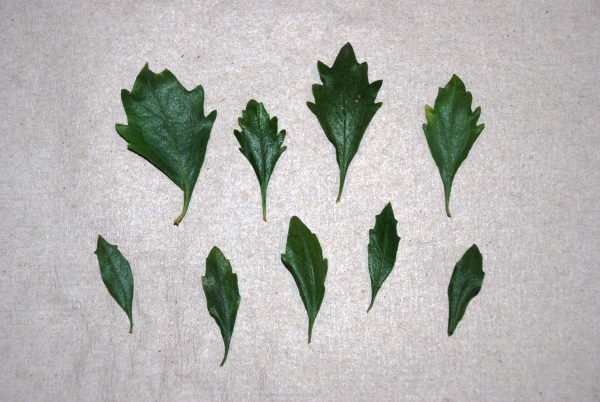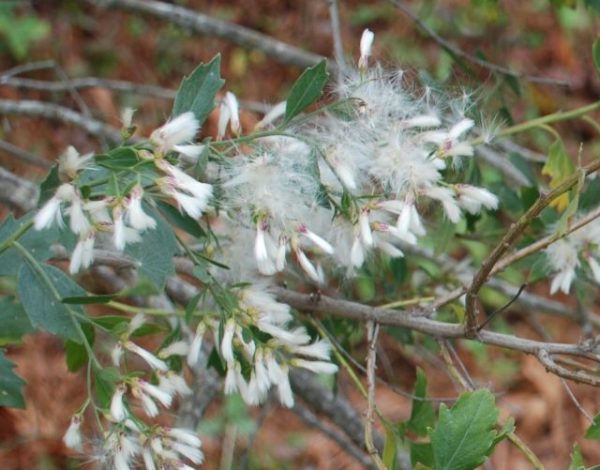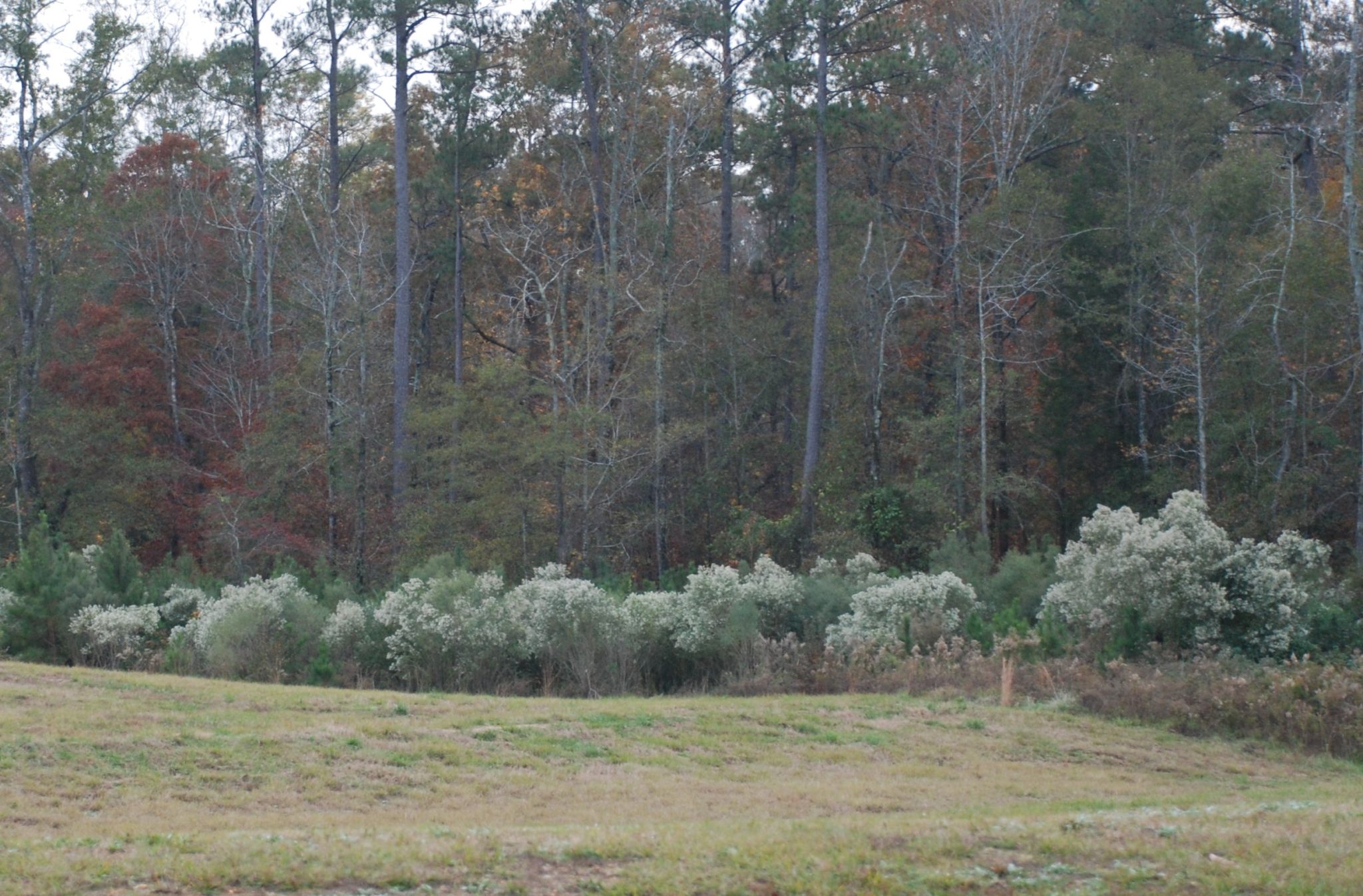Forestry & Wildlife

Eastern baccharis is a showy, often ornamental bush native to the Coastal Plain. Within pine plantations and pasturelands, however, it is an increasingly weedy plant that is difficult to control.

Figure 1. Eastern baccharis shrubs are easy to spot in the fall when covered in flowers or seedheads.
Eastern baccharis (Baccharis halimifolia), also known as groundsel tree, groundsel bush, or saltbush, grows on the edges of tidal fresh and brackish marshes, back dunes, and in open forests. Its distribution and naturalization may be largely attributed to commercial markets.
The form and density of these plants have been attractive characteristics dating back to the mid- nineteenth century when the species appeared in horticultural books, private gardens, and public parks. They are used in landscaping, as soil stabilizers, and as windbreaks.
More recently, however, the occurrence and spread of Eastern baccharis has been on the rise in areas prone to invasion—pine plantations, pastures, fencerows, field margins, open woods, roadsides, and disturbed areas. This bush may go unnoticed until it blooms in the fall (figure 1). To prevent its establishment as a weed, it is essential for growers and land managers to know how to identify it, where and how it grows, concerns with grazing, and control options.
Identification

Figure 2. Leaf shape is variable.
Form: shrub to small tree, 5 to 12 feet tall (figure 1); one to several stems and numerous erect branches; dioecious (separate male and female plants)
Leaves: alternate, somewhat leathery; semi-evergreen; bright green to grayish green; 1 to 3 inches long and 1/4 to 2 inches wide; variable shape from diamond to oval or elliptical (figure 2); larger leaves coarsely toothed on upper half; smaller leaves near tips of branches nearly smooth margins
Flowers: September to October; clusters of small white flowers at ends of branches; female plants quite showy as flowers mature, appearing covered with cotton
Fruit: October to November; small, wind-dispersed seeds with silky hairs (figure 3) produced in prolific numbers; seeds viable for about 1 year
Growth habits: typically found in open areas; seeds require light to germinate; tolerant of low-nutrient soils, flooding, moderate shade, and salt
Grazing restrictions: leaves and seeds poisonous to livestock and humans; may be attractive to cattle in winter when few green forages are available, but generally unpalatable and rarely a problem; not considered poisonous to white-tail deer but poor-to-moderate browse

Figure 3. Small, wind-dispersed seeds with silky hairs are produced in prolific numbers in the fall.
Control Options
Eastern baccharis can be challenging to manage. Herbicides may be the most effective and least costly means of control. Triclopyr ester and imazapyr are two of the more effective herbicide products, although the newer acid and choline salt formulations of triclopyr also show promise.
Each herbicide can be used as broadcast spray for site prep before planting or as an individual plant treatment (IPT) using cut stump, basal bark, or foliar application methods post planting (table 1).
Adding a nonionic surfactant (NIS) to foliar applications is generally recommended under favorable growing conditions. A crop oil concentrate (COC) may improve absorption under less-than-ideal moisture conditions.
There are several triclopyr ester and imazapyr products available. Select one that is labeled for the site. Glyphosate has not proven effective for foliar treatment and has not been tested for cut stump treatment.
If stems are cut, apply the selected herbicide to the top of the stump immediately after cutting, ensuring the cambium layer next to the bark is fully coated. If using a basal bark treatment, apply the herbicide mixed in oil to the lower 12 to 18 inches of the trunk. Foliar applications are successful only if full coverage is achieved, but excessive wetting is unnecessary.
Imazapyr is soil active, so do not overapply the solution causing runoff. Do not use imazapyr if the roots of desirable hardwoods extend into the treatment area. When using herbicides, always read and follow the label.
Eastern baccharis is somewhat intolerant of fire. Fire typically results in top kill, but mortality rates vary. A single fire may not provide good control. The causes
of this variation are not fully understood, and fire prescriptions for control are not currently available. Studies, however, show that growing-season fires and fires conducted when surface soil moisture levels are low (less than 40 percent) tend to have greater success.
Initiating control measures before flowering and maintaining dense ground cover (plants or duff) may inhibit seedling establishment, helping with long-term control.
Table 1. Recommended Herbicide Rates for Eastern Baccharis Control
2 ae = acid equivalent; ai = active ingredient
3 IPT (individual plant treatment) is the term used to distinguish herbicide rate recommendations on a percentage basis rather than a per-acre basis, which is used for broadcast treatments.
4 Add a nonionic surfactant at 0.5% v/v or a crop oil concentrate at 1% v/v.
5 Diesel can be used if on the label, but bark oils are preferred and safer.
| Herbicide Active Ingredient | Example Trade Names | Site1 | Application Method | Product Rate | Carrier |
|---|---|---|---|---|---|
| Triclopyr ester (4 lb. ae2; 60.45% ai) | Remedy Ultra, Garlon 4, other generics | Pastures, forests, ROWs | Foliar IPT3 | 2% v/v4 | Water |
| Triclopyr ester (4 lb. ae2; 60.45% ai) | Remedy Ultra, Garlon 4, other generics | Pastures, forests, ROWs | Cut stump | 25% v/v | Bark oil5 |
| Triclopyr ester (4 lb. ae2; 60.45% ai) | Remedy Ultra, Garlon 4, other generics | Pastures, forests, ROWs | Basal bark | 20% v/v | Bark oil |
| Triclopyr acid (2.87 lb. ae; 29.4% ai) | Trycera | Pastures, forests, aquatic, ROWs | Foliar IPT | 1–2% v/v4 | Water |
| Triclopyr acid (2.87 lb. ae; 29.4% ai) | Trycera | Pastures, forests, aquatic, ROWs | Cut stump | Undiluted | NA |
| Triclopyr acid (2.87 lb. ae; 29.4% ai) | Trycera | Pastures, forests, aquatic, ROWs | Basal bark | 25% v/v | Bark oil |
| Triclopyr choline (4 lb. ae; 54.72% ai) | Vastlan | Pastures, forests, aquatic, ROWs | Foliar IPT | 0.75–1.5% v/v4 | Water |
| Triclopyr choline (4 lb. ae; 54.72% ai) | Vastlan | Pastures, forests, aquatic, ROWs | Cut stump | Undiluted | NA |
| Imazapyr (2 lb. ae; 27.8% ai) | Arsenal, Polaris, and other generics | Pastures, forests, ROWs | Foliar IPT | 0.5–5% v/v4 | Water |
| Imazapyr (2 lb. ae; 27.8% ai) | Arsenal, Polaris, and other generics | Pastures, forests, ROWs | Cut stump | 8–12 oz. per gal. | Bark oil |
| Imazapyr (2 lb. ae; 27.8% ai) | Arsenal, Polaris, and other generics | Pastures, forests, ROWs | Basal bark | 8–12 oz. per gal. | Bark oil |
References
- Dickens, E. D., and D. J. Moorhead. 2020. “Groundsel Tree (Baccharis halimifolia, Baccarhis sp.) Control Herbicide Options.” University of Georgia, Warnell School of Forestry and Natural Resources, WSFNR-20-69.
- Van Deelen, T. R. 1991. “Baccharis halimifolia,” in Fire Effects Information System (online). U.S.
 Nancy Loewenstein, Extension Specialist, Forestry, Wildlife, and Environment, and David Russell, Extension Specialist, Crop, Soil and Environmental Sciences, both with Auburn University
Nancy Loewenstein, Extension Specialist, Forestry, Wildlife, and Environment, and David Russell, Extension Specialist, Crop, Soil and Environmental Sciences, both with Auburn University
New December 2022, Eastern Baccharis Identification & Control, FOR-2129

